Lexus IS220d 2012 Owner's Manual
Manufacturer: LEXUS, Model Year: 2012, Model line: IS220d, Model: Lexus IS220d 2012Pages: 609, PDF Size: 14.63 MB
Page 231 of 609

219
2-4. Using other driving systems
2
When driving
IS250/220d/200d_EERear corner sensors
Back sensors
Multi-information
displayApproximate distance
to obstacleBuzzer
50 to 37.5 cm
(1.6 to 1.2 ft.)Medium
37.5 to 25 cm
(1.2 to 0.8 ft.)Fast
25 cm (0.8 ft.) or lessContinuous
Multi-information
displayApproximate distance
to obstacleBuzzer
150 to 60 cm
(4.9 to 2.0 ft.)Slow
60 to 45 cm
(2.0 to 1.5 ft.)Medium
45 to 35 cm
(1.5 to 1.1 ft.)Fast
35 cm (1.1 ft.) or lessContinuous
Page 232 of 609

220
2-4. Using other driving systems
IS250/220d/200d_EE
Detection range of the sensors
Approximately 50 cm (1.6
ft.)
Approximately 50 cm (1.6
ft.)
Approximately 150 cm (4.9
ft.)
The diagram shows the detec-
tion range of the sensors. Note
that the sensors cannot detect
obstacles that are extremely
close to the vehicle.
The range of the sensors may
change depending on the shape
of the object etc.
Page 233 of 609

221
2-4. Using other driving systems
2
When driving
IS250/220d/200d_EE
Page 234 of 609

222
2-4. Using other driving systems
IS250/220d/200d_EE
Sensor detection information
Certain vehicle conditions and the surrounding environment may affect
the ability of the sensor to correctly detect obstacles. Particular instances
where this may occur are listed below.
• There is dirt, snow or ice on the sensor.
• The sensor is frozen.
• The sensor is covered in any way.
• The vehicle is leaning considerably to one side.
• On an extremely bumpy road, on an incline, on gravel, or on grass.
• The vicinity of the vehicle is noisy due to vehicle horns, motorcycle
engines, air brakes of large vehicles, or other loud noises producing
ultrasonic waves.
• There is another vehicle equipped with parking assist sensors in the
vicinity.
• The sensor is coated with a sheet of spray or heavy rain.
• The vehicle is equipped with a fender pole or wireless antenna.
• Towing eyelets are installed.
• The bumper or sensor receives a strong impact.
• The vehicle is approaching a tall or curved curb.
• In harsh sunlight or intense cold weather.
In addition to the examples above, there are instances in which, because of
their shapes, signs and other objects may be judged by the sensor to be
closer than they are.
The shape of the obstacle may prevent the sensor from detecting it. Pay
particular attention to the following obstacles.
• Wires, fences, ropes etc.
• Cotton, snow and other materials that absorb radio waves
• Sharply-angled objects
•Low obstacles
• Tall obstacles with upper sections projecting outwards in the direction
of your vehicle
If the display flashes and a message is displayed
P. 4 7 3
Customization that can be configured at any authorized Lexus dealer or
repairer, or another duly qualified and equipped professional
Settings (e.g. buzzer volume) can be changed. (Customizable features P.
556)
Page 235 of 609

223
2-4. Using other driving systems
2
When driving
IS250/220d/200d_EE
CAUTION
Caution when using the Lexus parking assist-sensor
Observe the following precautions.
Failing to do so may result in the vehicle being unable to be driven safely
and possibly cause an accident.
Do not use the sensor at speeds in excess of 10 km/h (6 mph).
Do not attach any accessories within the sensor range.
NOTICE
Notes when washing the vehicle
Do not apply intensive bursts of water or steam to the sensor area.
Doing so may result in the sensor malfunctioning.
Page 236 of 609
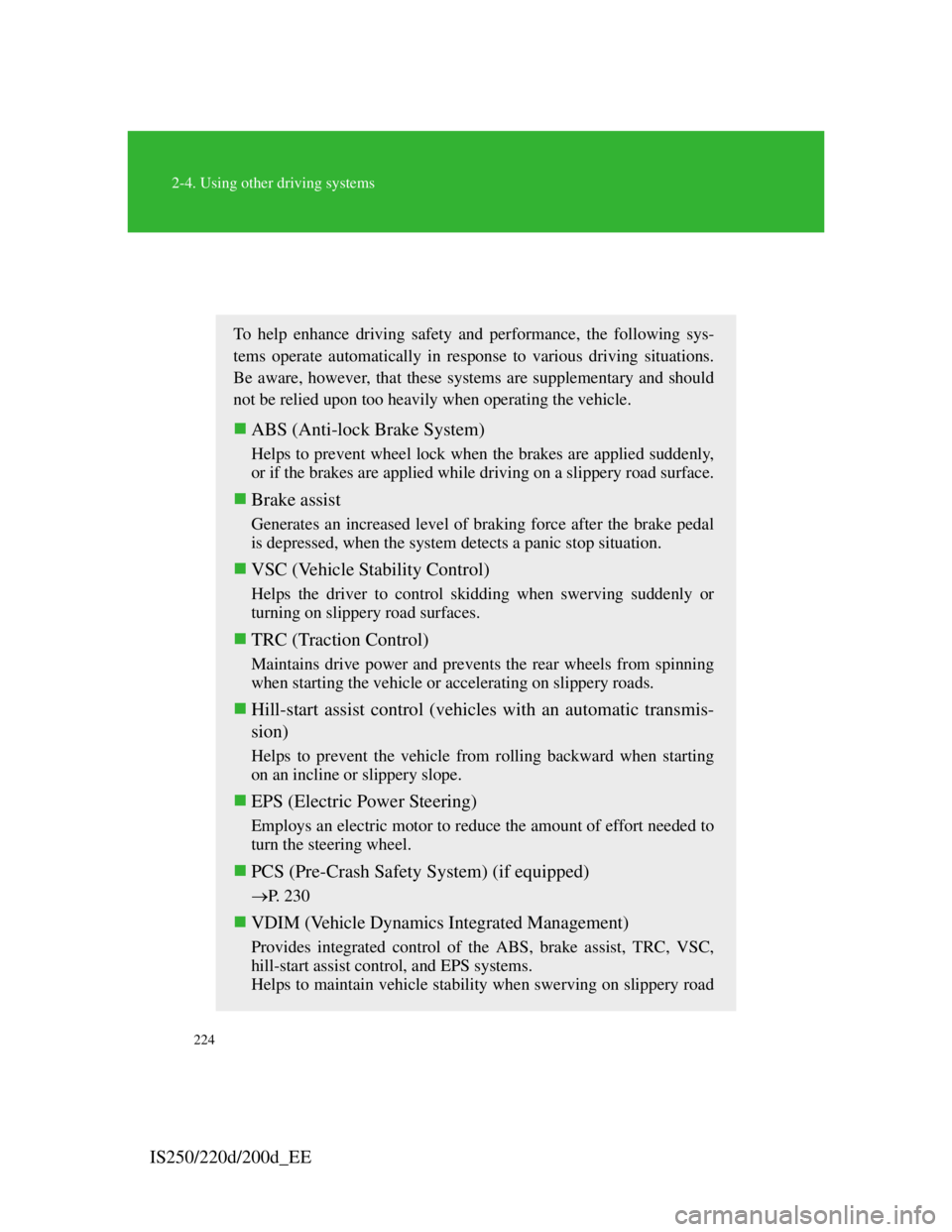
224
2-4. Using other driving systems
IS250/220d/200d_EE
Driving assist systems
To help enhance driving safety and performance, the following sys-
tems operate automatically in response to various driving situations.
Be aware, however, that these systems are supplementary and should
not be relied upon too heavily when operating the vehicle.
ABS (Anti-lock Brake System)
Helps to prevent wheel lock when the brakes are applied suddenly,
or if the brakes are applied while driving on a slippery road surface.
Brake assist
Generates an increased level of braking force after the brake pedal
is depressed, when the system detects a panic stop situation.
VSC (Vehicle Stability Control)
Helps the driver to control skidding when swerving suddenly or
turning on slippery road surfaces.
TRC (Traction Control)
Maintains drive power and prevents the rear wheels from spinning
when starting the vehicle or accelerating on slippery roads.
Hill-start assist control (vehicles with an automatic transmis-
sion)
Helps to prevent the vehicle from rolling backward when starting
on an incline or slippery slope.
EPS (Electric Power Steering)
Employs an electric motor to reduce the amount of effort needed to
turn the steering wheel.
PCS (Pre-Crash Safety System) (if equipped)
P. 230
VDIM (Vehicle Dynamics Integrated Management)
Provides integrated control of the ABS, brake assist, TRC, VSC,
hill-start assist control, and EPS systems.
Helps to maintain vehicle stability when swerving on slippery road
Page 237 of 609
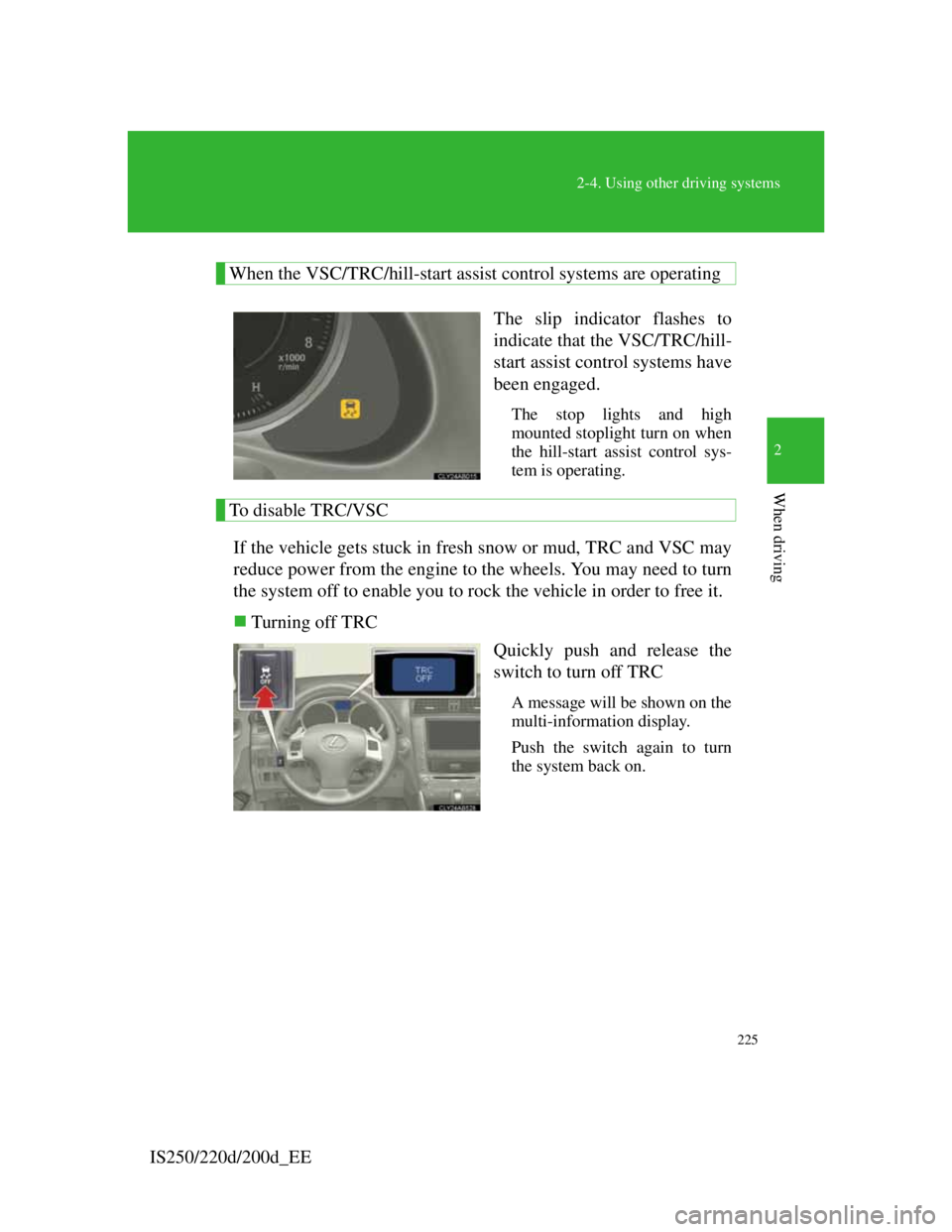
225
2-4. Using other driving systems
2
When driving
IS250/220d/200d_EE
When the VSC/TRC/hill-start assist control systems are operating
The slip indicator flashes to
indicate that the VSC/TRC/hill-
start assist control systems have
been engaged.
The stop lights and high
mounted stoplight turn on when
the hill-start assist control sys-
tem is operating.
To disable TRC/VSC
If the vehicle gets stuck in fresh snow or mud, TRC and VSC may
reduce power from the engine to the wheels. You may need to turn
the system off to enable you to rock the vehicle in order to free it.
Turning off TRC
Quickly push and release the
switch to turn off TRC
A message will be shown on the
multi-information display.
Push the switch again to turn
the system back on.
Page 238 of 609
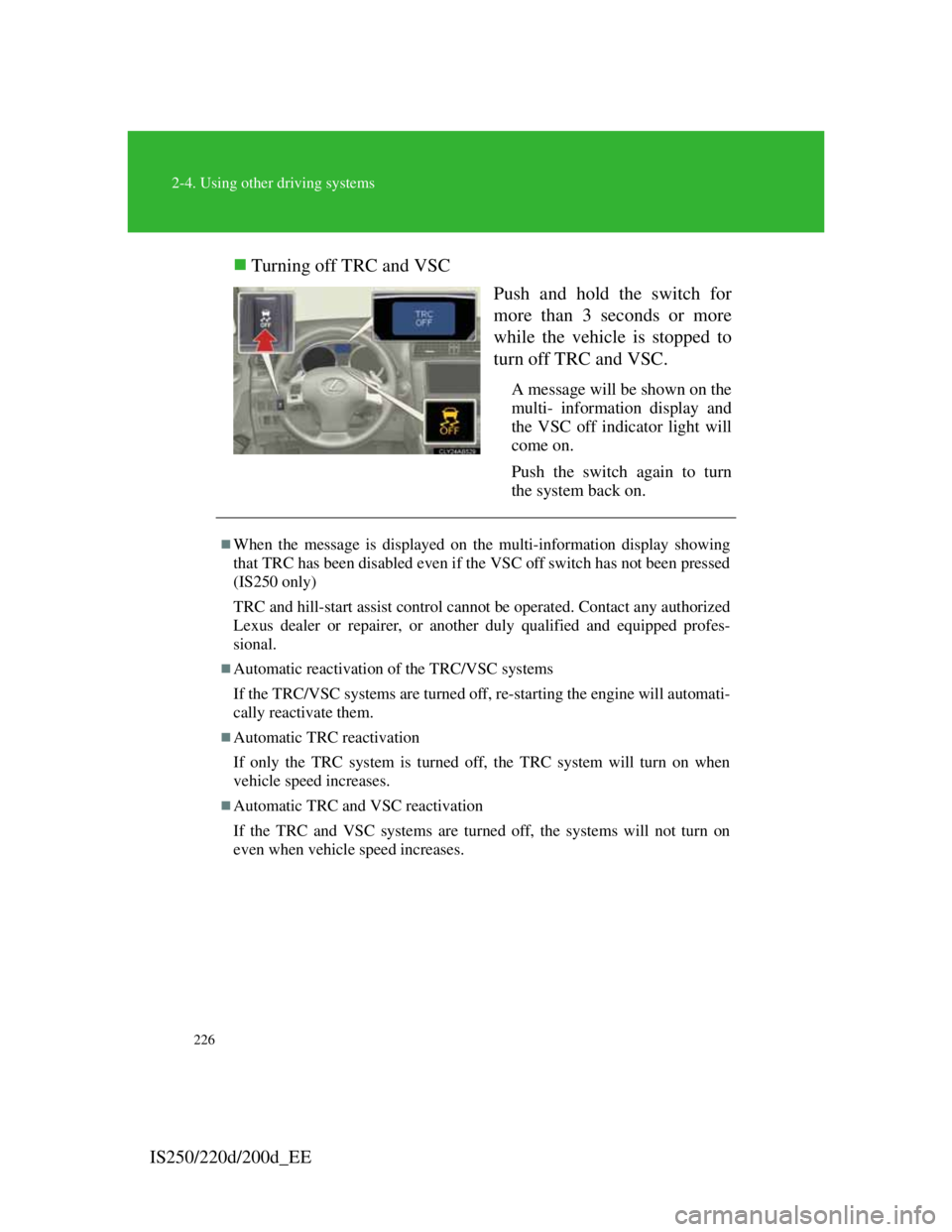
226
2-4. Using other driving systems
IS250/220d/200d_EETurning off TRC and VSC
Push and hold the switch for
more than 3 seconds or more
while the vehicle is stopped to
turn off TRC and VSC.
A message will be shown on the
multi- information display and
the VSC off indicator light will
come on.
Push the switch again to turn
the system back on.
When the message is displayed on the multi-information display showing
that TRC has been disabled even if the VSC off switch has not been pressed
(IS250 only)
TRC and hill-start assist control cannot be operated. Contact any authorized
Lexus dealer or repairer, or another duly qualified and equipped profes-
sional.
Automatic reactivation of the TRC/VSC systems
If the TRC/VSC systems are turned off, re-starting the engine will automati-
cally reactivate them.
Automatic TRC reactivation
If only the TRC system is turned off, the TRC system will turn on when
vehicle speed increases.
Automatic TRC and VSC reactivation
If the TRC and VSC systems are turned off, the systems will not turn on
even when vehicle speed increases.
Page 239 of 609
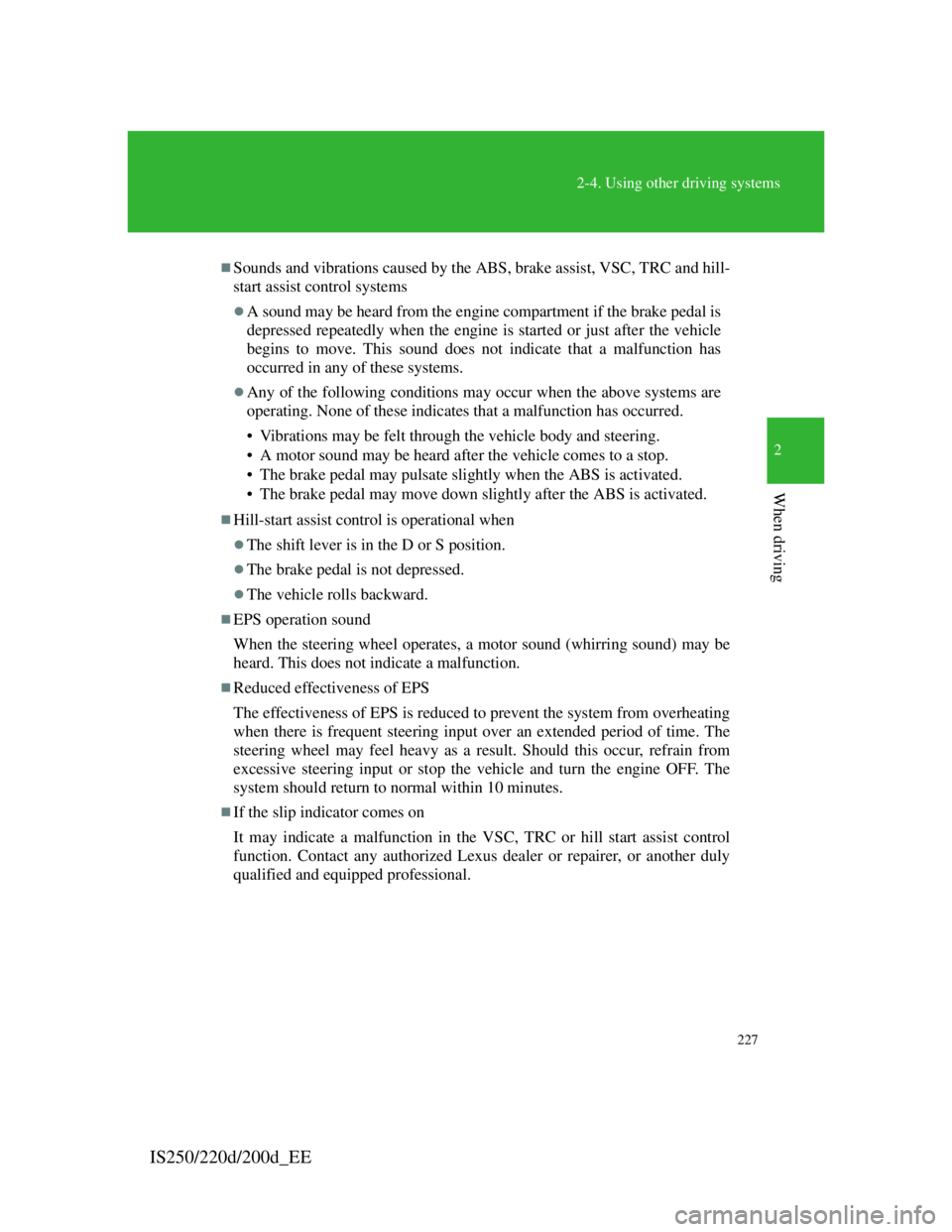
227
2-4. Using other driving systems
2
When driving
IS250/220d/200d_EE
Sounds and vibrations caused by the ABS, brake assist, VSC, TRC and hill-
start assist control systems
A sound may be heard from the engine compartment if the brake pedal is
depressed repeatedly when the engine is started or just after the vehicle
begins to move. This sound does not indicate that a malfunction has
occurred in any of these systems.
Any of the following conditions may occur when the above systems are
operating. None of these indicates that a malfunction has occurred.
• Vibrations may be felt through the vehicle body and steering.
• A motor sound may be heard after the vehicle comes to a stop.
• The brake pedal may pulsate slightly when the ABS is activated.
• The brake pedal may move down slightly after the ABS is activated.
Hill-start assist control is operational when
The shift lever is in the D or S position.
The brake pedal is not depressed.
The vehicle rolls backward.
EPS operation sound
When the steering wheel operates, a motor sound (whirring sound) may be
heard. This does not indicate a malfunction.
Reduced effectiveness of EPS
The effectiveness of EPS is reduced to prevent the system from overheating
when there is frequent steering input over an extended period of time. The
steering wheel may feel heavy as a result. Should this occur, refrain from
excessive steering input or stop the vehicle and turn the engine OFF. The
system should return to normal within 10 minutes.
If the slip indicator comes on
It may indicate a malfunction in the VSC, TRC or hill start assist control
function. Contact any authorized Lexus dealer or repairer, or another duly
qualified and equipped professional.
Page 240 of 609
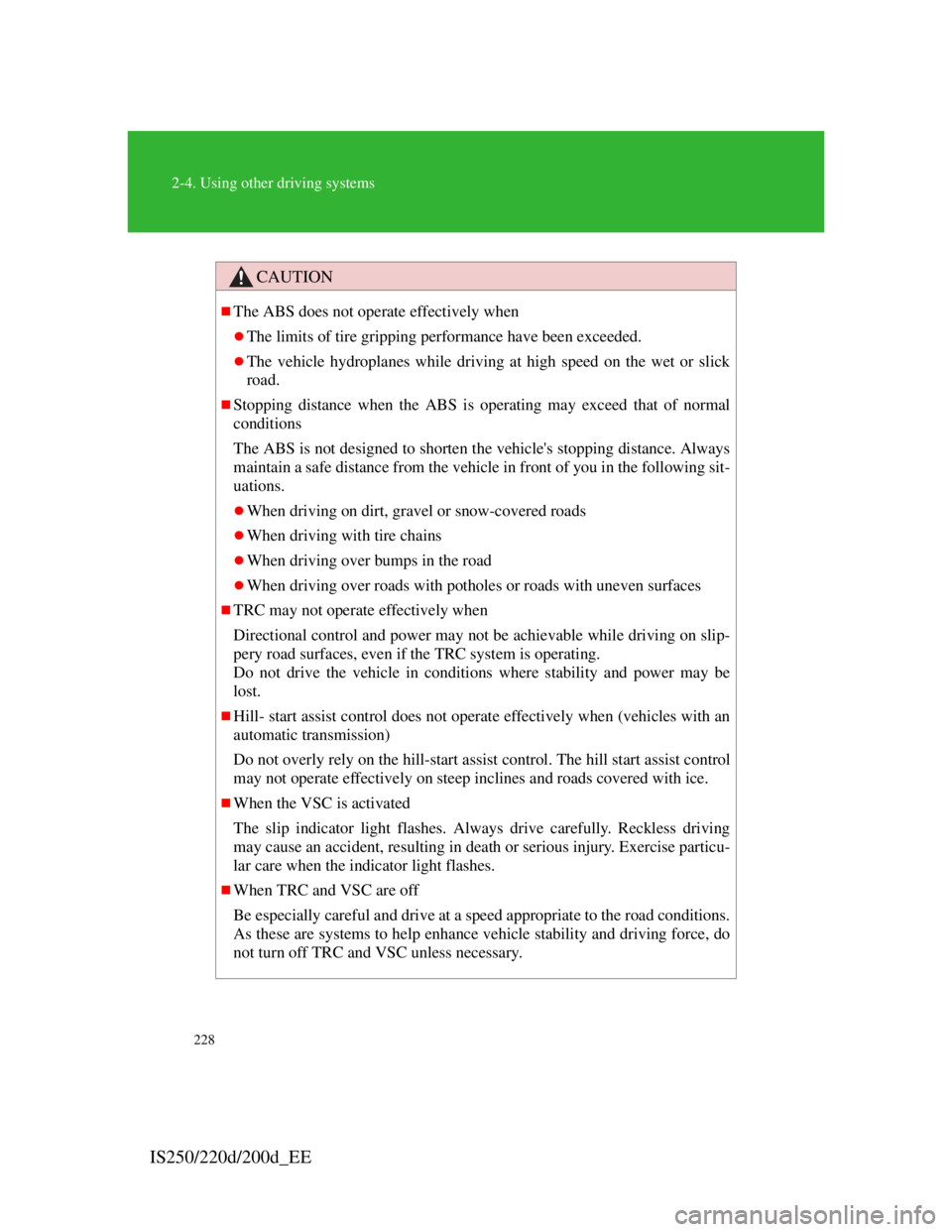
228
2-4. Using other driving systems
IS250/220d/200d_EE
CAUTION
The ABS does not operate effectively when
The limits of tire gripping performance have been exceeded.
The vehicle hydroplanes while driving at high speed on the wet or slick
road.
Stopping distance when the ABS is operating may exceed that of normal
conditions
The ABS is not designed to shorten the vehicle's stopping distance. Always
maintain a safe distance from the vehicle in front of you in the following sit-
uations.
When driving on dirt, gravel or snow-covered roads
When driving with tire chains
When driving over bumps in the road
When driving over roads with potholes or roads with uneven surfaces
TRC may not operate effectively when
Directional control and power may not be achievable while driving on slip-
pery road surfaces, even if the TRC system is operating.
Do not drive the vehicle in conditions where stability and power may be
lost.
Hill- start assist control does not operate effectively when (vehicles with an
automatic transmission)
Do not overly rely on the hill-start assist control. The hill start assist control
may not operate effectively on steep inclines and roads covered with ice.
When the VSC is activated
The slip indicator light flashes. Always drive carefully. Reckless driving
may cause an accident, resulting in death or serious injury. Exercise particu-
lar care when the indicator light flashes.
When TRC and VSC are off
Be especially careful and drive at a speed appropriate to the road conditions.
As these are systems to help enhance vehicle stability and driving force, do
not turn off TRC and VSC unless necessary.